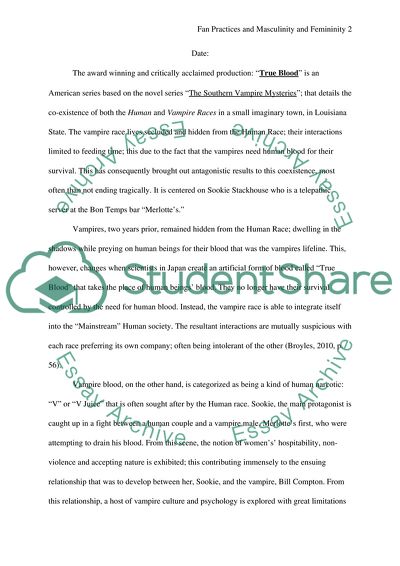Cite this document
(Fan Practices and Masculinity and Femininity Essay, n.d.)
Fan Practices and Masculinity and Femininity Essay. https://studentshare.org/visual-arts-film-studies/1768403-how-might-the-fan-practices-that-produce-a-cult-text-be-categorised-as-masculine-or-femine-your-answers-should-be-illustrated-with-analysis-of-the-gendered-competencies-and-dispositions-linked-to-the-american-series-of-true-blood
Fan Practices and Masculinity and Femininity Essay. https://studentshare.org/visual-arts-film-studies/1768403-how-might-the-fan-practices-that-produce-a-cult-text-be-categorised-as-masculine-or-femine-your-answers-should-be-illustrated-with-analysis-of-the-gendered-competencies-and-dispositions-linked-to-the-american-series-of-true-blood
(Fan Practices and Masculinity and Femininity Essay)
Fan Practices and Masculinity and Femininity Essay. https://studentshare.org/visual-arts-film-studies/1768403-how-might-the-fan-practices-that-produce-a-cult-text-be-categorised-as-masculine-or-femine-your-answers-should-be-illustrated-with-analysis-of-the-gendered-competencies-and-dispositions-linked-to-the-american-series-of-true-blood.
Fan Practices and Masculinity and Femininity Essay. https://studentshare.org/visual-arts-film-studies/1768403-how-might-the-fan-practices-that-produce-a-cult-text-be-categorised-as-masculine-or-femine-your-answers-should-be-illustrated-with-analysis-of-the-gendered-competencies-and-dispositions-linked-to-the-american-series-of-true-blood.
“Fan Practices and Masculinity and Femininity Essay”. https://studentshare.org/visual-arts-film-studies/1768403-how-might-the-fan-practices-that-produce-a-cult-text-be-categorised-as-masculine-or-femine-your-answers-should-be-illustrated-with-analysis-of-the-gendered-competencies-and-dispositions-linked-to-the-american-series-of-true-blood.


